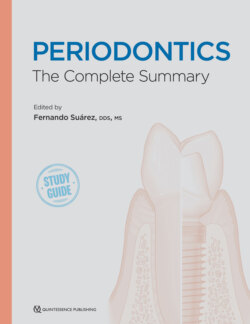Читать книгу Periodontics - Fernando Suarez - Страница 102
На сайте Литреса книга снята с продажи.
ACCESSORY CANALS
ОглавлениеAccessory root canals are considered a lateral branch of the main root canal most often found in the apical half of the roots and in furcation areas.1 The formation of these accessory root canals has been labeled as lines of weakness and attributed to a defect in the HERS during the development of the root at the site of a larger vessel.136,137 The size of the foramina of these canals might range between 4 and 250 μm, and the canals are more numerous and larger in diameter among maxillary molars than mandibular molars.138 Early studies reported the presence of an accessory apical artery entering the tooth via the periodontal ligament.139 Kramer demonstrated large blood vessels within the furcation region running through the radicular dentin to supply one root canal vascular system.140 At times, these vessels appeared to contribute more to the root canal vascular supply than those entering the apical foramen.140
The terminology used to describe root canal ramifications is diverse. De Deus identified different types of root canals based on their location (eg, apex, body, and coronal third) as accessory, secondary, and lateral canals.141 Some authors have referred to them as furcation canals when they are exclusively located at the furcation region.142,143
Vertucci and Williams reported a 46% prevalence of accessory canals in a study of 100 mandibular molars.143 The authors also established an association between their occurrence and the site of origin (pulp chamber or root surface) and the possibility to have multiple accessory canals. Conversely, Kirkham found that 23% of the teeth had accessory canals and reported an association with periodontal defects in 2% of the cases.144 In a similar manner, Gutmann reported a prevalence of 28.4% of accessory canals at furcation regions from maxillary and mandibular molars.142 Finally, De Deus used a sample of 1,140 teeth and reported an overall (27.4%) and a site-specific prevalence (apex: 17%; body: 8.8%; and base: 1.6% of the root)141 (Fig 5-4).
Fig 5-4 Prevalence of accessory canals.
Overall, a large variation (17% to 92.5%) for the prevalence of accessory canals has been observed. This wide range can potentially be attributed to multiple factors.124,141–149 It is important to bear in mind that these canals are encased by dentin, and a calcification process might cause the number of canals to diminish with age.150 Also, subtle differences can be associated with the tooth type,143,145,146 the reason for extraction (eg, caries, periodontal disease, endodontic failure), deposition of cementum,147 and processing methods (eg, drying, vulcanizing).151
